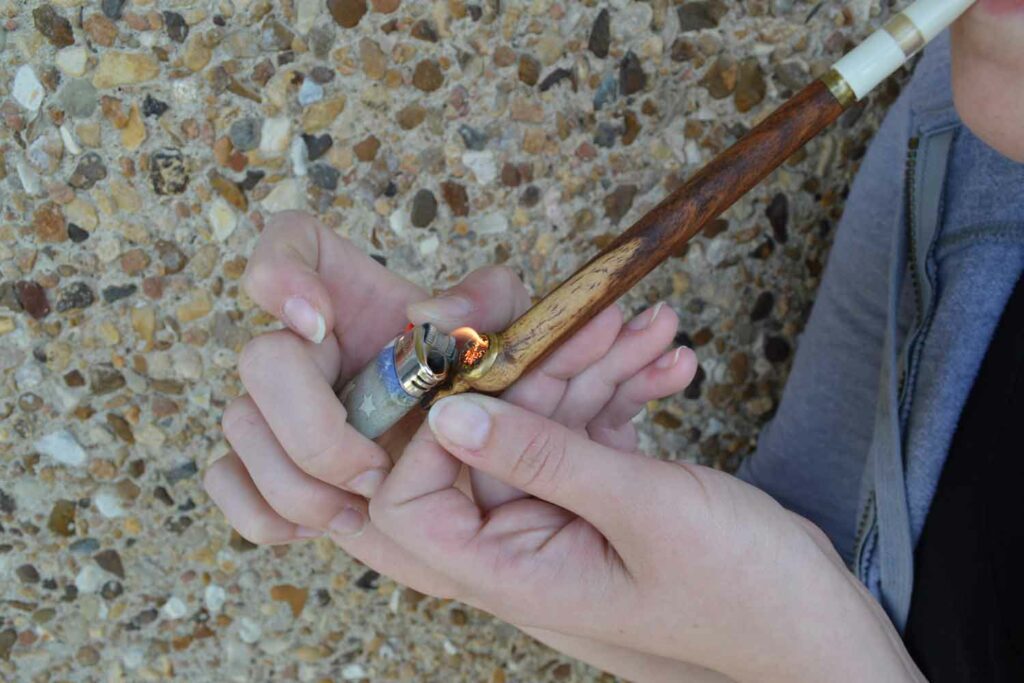Traveling abroad
Smoking dokha outside the Middle East was a rarity until the 21st century. BKG was established in 1987 by a small farmer with a strong desire to provide the highest-quality dokha. At the time, it was a small shop with only few blends of dokha and some wooden pipes. The company now has almost 200 employees. In 2003, BKG began selling dokha on the international market. Following a surge in dokha demand within the UAE, the company expanded by setting up divisions in Oman, Qatar, Saudi Arabia, Europe and the U.S.
“We used to sell our dokha to a few companies who packed them under their brand with the writing Bin Khumery dokha,” says Behzod. “After a certain period of time, we noticed that some of those companies were selling product that was not the one we were sending them; they were mixing some very low-quality dokha and selling it with our name, thereby damaging our reputation. As a result, we came up with idea of Turbo, the best-quality dokha on the market and always consistently the same. The Turbo brand consists of 19 blends of dokha, four types of medwakh, five types of filters and two types of pipe cleaner.”
In 2006, after Chahine’s father brought his family to the U.S. from the UAE, he soon realized there was no reliable source of dokha in his adopted home country. While operating a hookah lounge, Chahine began to notice how Arab students would share and smoke any dokha they somehow had managed to bring from their homeland. Alert to opportunity, Chahine traded an old Playstation game console with a friend in the UAE for three 1.5-liter bottles of dokha.
In November of 2009, Medwakh.com went online, becoming the first company to establish a legitimate online presence for dokha sales. “Within three minutes of going live, we made our first sale,” says Chahine. “We were floored.” The success of Medwakh.com has snowballed from there.
The company started with three types of unflavored dokha and today imports and manufactures more than 200 types and flavors under three different brand names: Medwakh.com, Nirvana Dokha and Something Girlie Dokha. “Having seen how popular dokha was when anyone had any to share in our hookah lounge and how interested our American customers were in it, I was absolutely sure there was a market for it here,” says Chahine. “My family has been involved, one way or another, in the tobacco business in the Middle East for at least five generations.”
Having that family history, and growing up in the UAE, eventually allowed Chahine to secure a reliable supplier. The company now buys its dokha directly from farms in the UAE and Oman through annual contracts.
Behzod says the demand for dokha in the international market is gradually growing, but BKG is focused mainly on the Middle East and some European countries at the moment. “However, we are ready to supply countries that are interested in our products. It is vital for us to grow organically to sustain the unique quality of the product,” he says.
Over the last few years, dokha has exploded onto the U.S. market, says Chahine. When the company started, its employees kept track of geographical sales by pinning pins onto a map. They quickly ran out of space though; within 18 months, the company had sold to all 50 U.S. states, 70 countries and six of the seven continents. To date, the company has sent dokha to more than 125 countries. Medwakh.com sold a little more than $300,000 worth of product in 2010. In 2014, the company expects to easily exceed $3 million in gross sales.
“We’ve been concentrating on building a wholesale/distribution network for the last year or so, and I’ve been advised that we will double our 2014 sales in 2015,” says Chahine. “In 2010, I worked out of half of an office in my house and literally did everything myself. Today, we have 28 extremely dedicated employees, a 3,500-square-foot warehouse, a shipping and manufacturing facility, a corporate office with a phone-sales staff, a half dozen proprietary retail outlets, 45,000 unique online retail customers and over 500 wholesale/distribution customers. We will import between 2,500 and 3,000 kilos of raw dokha this year.”
In contrast, Behzod said that BKG could not disclose its financials, although he assured Tobacco Reporter that BKG is the largest dokha producer in the UAE, as well as in the world. “We are a family that is built of competent and dedicated employees with the skills to maintain the quality of the products, dynamic growth and corporate culture of the company,” said Behzod. “Our Turbo dokha is a combination of traditional farming skills and unique blending technologies that allows us to produce a superior product for the UAE and the international market.”
Medwakh.com says it is now the world’s largest online supplier of dokha, and by the end of 2015, Chahine says the company will be the world’s largest dokha supplier overall. “All it takes is for someone to whip out their medwakh at a public event and light a bowl of dokha, and a crowd of people will soon gather and ask, ‘What’s that?’ and the all-important, ‘Where do you get it?’” says Chahine. “By the end of the summer, we’ll have distributors in the U.K., Germany, Russia, Argentina, Norway, Ukraine, Turkey, and who knows who’ll be calling tomorrow.”













